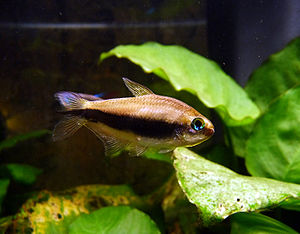Emperor tetra
| Emperor tetra | ||||||||||||
|---|---|---|---|---|---|---|---|---|---|---|---|---|

Emperor tetra |
||||||||||||
| Systematics | ||||||||||||
|
||||||||||||
| Scientific name | ||||||||||||
| Nematobrycon palmeri | ||||||||||||
| Eigenmann , 1911 |
The Nematobrycon Palmeri ( Nematobrycon palmeri ) even Emperor Tetra called, is a freshwater ornamental fish from the family of Real tetras . It is a popular aquarium fish because of its comparatively uncomplicated keeping.
features
Nematobrycon palmeri is the type species of the genus Nematobrycon, which was established in 1911 by ichtologist Carl H. Eigenmann . As a genus definition, it shows the combination of the three-lobed caudal fin and the lack of the adipose fin so typical of the tetras, which is unique within the characidae family .
Adult emperor tetra are about 5 to 8 cm tall.
The iridescent blue vertical stripe above the sideline can glow very intensely, depending on the condition of the fish. During the courtship season , the colors of the male intensify very strongly, the belly glows purple and the fins are patterned with rich contrasts.
Emperor tetra are extremely sexually dimorphic, so that males and females can easily be distinguished from one another. The most reliable method is the color of the iris : males have metallic blue eyes, while females have metallic green eyes. In addition, the male has a three-pointed tail, with the middle black stripe usually extending beyond the rest of the tail, while in the females this medium black stripe usually only extends to the clear part of the tail. However, this is not always the best indicator, as the third prong can be damaged in males after territorial fights, and in more dominant females this extension of the tail sometimes grows as well.
distribution
It originally comes from the west of Colombia in the Colombian region of Choco, and occurs in the Río San Juan and the Río Atrato and their tributaries.
Way of life
Nematobrycon species live in their natural environment in small forest ponds that only come into contact with the upper reaches of rivers during periods of flooding. Other sources give the mouth areas of the corresponding river systems as habitat.
Aquaristics
Nematobrycon palmeri was rediscovered by the ornamental fish importer William A. Kyburz at the end of the 1950s and was first introduced to the USA in the 1960s. Due to their relatively uncomplicated reproduction for the tetras, the aquarium hobby needs are mainly covered by offspring today. Emperor tetra are suitable for community tanks, where they should be kept in small groups of 8–12 animals to develop their specific social behavior. They should not be kept together with fish that are too lively or even aggressive. The pool length should be at least 70 cm and the posture should be carried out at a temperature of 23 to 27 ° C. Dominant males sometimes show pronounced territorial behavior.
nutrition
The Kaisersalmler is an omnivore that consumes both animal and vegetable food. Flake food, pelleted fish food or food tablets can be used for basic nutrition as well as frozen or live Artemia or mosquito larvae.
breed
It works best in a densely planted, sparsely populated species basin in soft water. Well-nourished couples lay a single egg on plants after the courtship dance. Since the parents are spawning predators, eggs and young animals in thick vegetation (e.g. Java moss pads) have a statistically higher chance of survival. After hatching, the approximately 2 mm long young can be reared in their own rearing tank with powdered food.
Alternatively, you can also spend courting breeding pairs in a smaller spawning pool with dense bottom vegetation, and after their removal the hatching young can be raised there.
Related species
In addition to the emperor tetra, the genus Nematobrycon has only one other species, the red-eye emperor tetra ( Nematobrycon lacortei ). A previously described third species (Nematobrycon amphiloxus) has meanwhile turned out to be a dark color variant of Nematobrycon palmeri (“Nematobrycon palmeri Black”). Albinotic mutations or cultivated forms also occur. It is considered likely that there may be as yet unknown Nematobrycon populations in the catchment of the numerous rivers in southwestern Colombia. Another previously undescribed possible Nematobrycon species (provisional name Inpaichthys sp.Yellow Devil) is said to come from Brazil.
literature
- Rüdiger Riehl and Hans A. Baensch : Aquarien Atlas , Volume 1, Mergus Verlag, Melle, 9th edition 1994, ISBN 3-88244-017-1 , p. 304 f.
Web links
- Kaisersalmler on Fishbase.org (English)
Individual evidence
- ↑ Kaisersalmler - beautiful Colombians. Aqualog animalbook GmbH, accessed on March 24, 2020 .
- ↑ Nematobrycon palmeri - Kais ertra. In: my-fish.org. Wirtschaftsgemeinschaft Zoologischer Fachbetriebe GmbH (WZF), accessed on March 24, 2020 .
- ↑ Emperor tetra (Nematobrycon palmeri). In: fischlexikon.eu. WESO Software GmbH, accessed on March 24, 2020 .
- ↑ Emperor tetra in the aquarium: data sheet, keeping and breeding. In: drta-archiv.de. eEducation Net eK, accessed on March 24, 2020 .